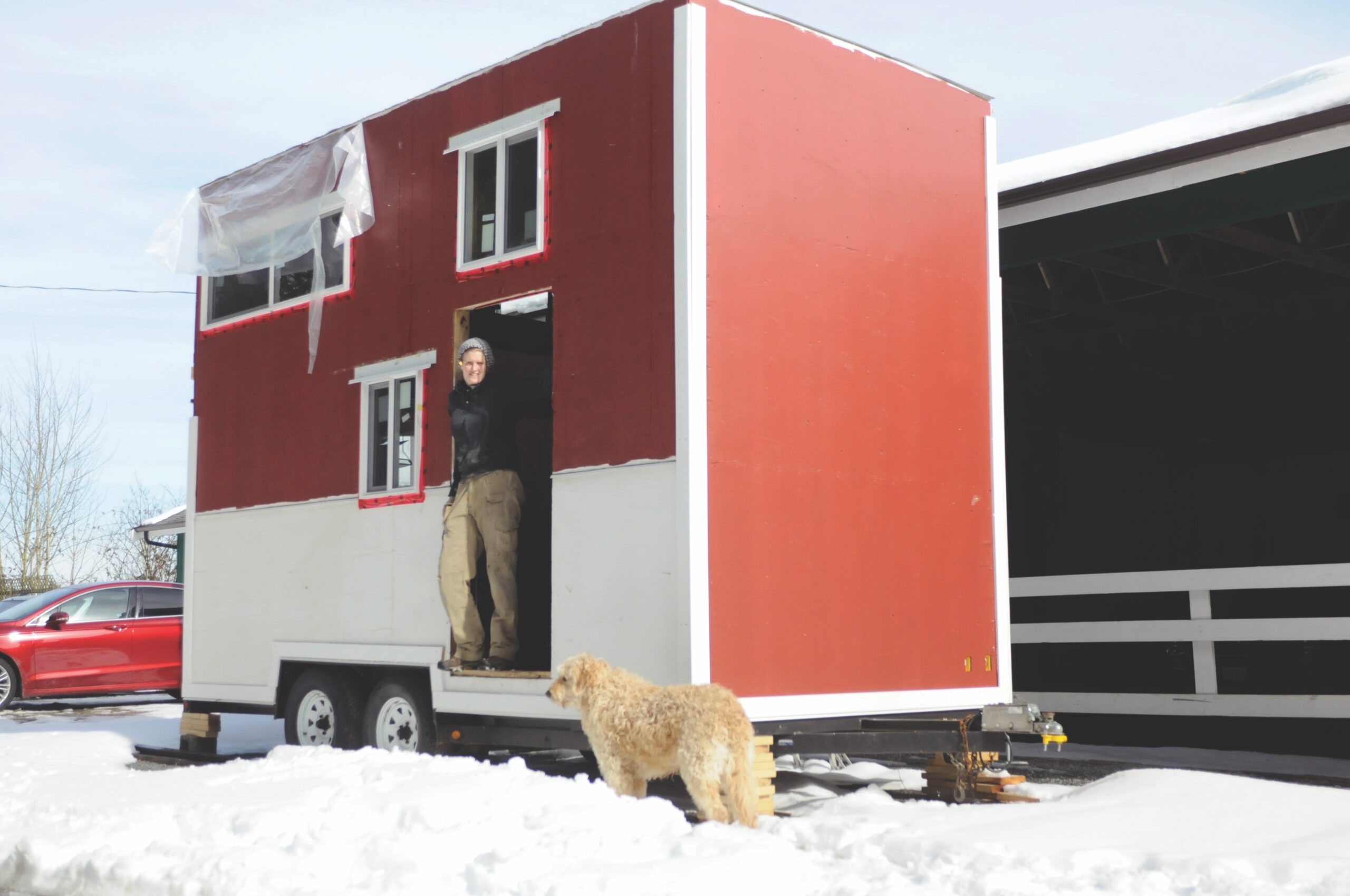Two years ago, Kayla Feenstra’s offer on a house in Abbotsford, B.C., fell through at the last minute after the bank told her she needed to increase her down payment by an additional $10,000 because she was self-employed. “That was my epiphany moment,” says the 31-year-old landscaper. “I started thinking, do I really want a $300,000 mortgage? How much space do I really need?”
Turns out, not a lot. In fact, a mere 130 square feet would do it.
You may unsubscribe from any of our newsletters at any time.
Feenstra, who grew up helping her father construct houses, built her simple shelter, which she nicknamed “Jack in a Box,” on a trailer bed. The off-grid home on wheels features solar panels, a composting toilet and an 1,800-litre tank to collect rainwater. Its airy 11-foot ceiling accommodates the six-foot-two Feenstra, who shares the quarters with her cat, Jinx, and 100-pound dog, Scotch. The house cost her $15,000 to build — less than the original down payment the bank wanted.
Her modest abode, currently parked on the blackberry-covered land of a local for whom she provides property services, has allowed her to have a richer life. “This fits with my sense of spirituality — it’s less materialist, more connected to nature, gives me the solitude I need and there’s definitely a lot less stress financially,” says Feenstra, who attributes her desire for the simple life to a three-year stint spent volunteering in Haiti in her early 20s. “I don’t want to be a slave to a mortgage. I want to have the freedom to do what I want and not be 70 years old when my house is finally paid off.”
The desire to scale back, live simply, leave a softer footprint, become more self-sufficient — and a whole lot happier — is propelling a tiny house movement of people like Feenstra who are tossing their worldly possessions and opting for low-maintenance living quarters that rival the size of a storage locker. These maverick homesteaders say having less stuff, fewer bills, no mortgage and reduced expenses means they can work less and live more. As tiny house designer Jay Shafer, one of the leaders of this micro-housing revolution, says, “Your world gets bigger when you get small.”
Choosing this radical lifestyle has its challenges. For one, you’ll have to give up your big-screen TV, king bed and industrial-grade appliances. For another, you’ll likely wrangle with lots of red tape since restrictive zoning rules and building codes can make it challenging to find a place to put your tiny house. And if you’re squeamish about the idea of emptying a composting toilet, it may not be for you.
Tiny houses typically measure less than 500 square feet, and those on wheels must be less than 120 square feet to be classified as mobile homes — and thus be exempt from the need for building permits. They cost $10,000 at the low end if you build your own and up to $80,000 or more if you order a custom model from a specialized tiny house builder.
“These are not a bunch of rickety shacks being built by crazy people,” says Feenstra. Indeed, some high-end diminutive dwellings are the Monacos of the tiny house world: small but opulent, with fancy features such as granite countertops, stainless steel appliances and bamboo flooring. Manufacturers add to their allure by slapping on folksy monikers such as “The Acorn,” “Vagabode” or “Heirloom.”
Some of these pocket-sized pads are year-round homes, while others are vacation digs, backyard cottages or retirement residences for aging parents. A few industrious U.S. teenagers have made headlines by building their own tiny houses in the backyards of their family homes, an ingenious way to escape hectoring parents. Space is typically too tight to accommodate families — it’s mostly empty nesters and millennials who are drawn to these miniature residences.
There’s no denying the financial benefits of this mini-housing revolution, especially when you consider that most of us dedicate almost half our income for almost all of our working lives to putting a roof over our heads. And the costs keep climbing as houses have ballooned in size to encompass multiple powder rooms and three-car enclosed garages. The average size of a new Canadian home in 2010 was 1,950 square feet, nearly double the 1975 average house size of 1,050 square feet.
Meanwhile, the average number of inhabitants has dropped from 3.5 in 1971 to 2.5 in 2011. Nationally, the average house price is $420,000, more than six times the typical income of 25- to 34-year-olds. For many, owning a dream home has become a financial nightmare, one that binds them to jobs they hate and makes them stay in unhappy marriages because of fear of financial ruin. “In the wake of the United States’ housing crisis and the overall global recession, the single-family home — once the celebratory site of domestic accomplishment — has become not a symbol of pride and freedom, but a prison of economic uncertainty,” writes Mimi Zeiger in her book Micro Green: Tiny Houses in Nature.
***
Matthew Davey, 31, and Kat Walters, 26, don’t want any part of the housing hamster wheel. The couple prepared themselves for tiny house living by travelling across the United States for eight months last year in a 54-square-foot moulded fibreglass Cadet trailer. They’re now building their $20,000 home — made with reclaimed materials including 140-year-old barn board — on the back of a flatbed trailer. Like many tiny do-it-yourselfers, they tracked the progress of their home’s construction on their blog, Hobohemians.
The couple’s cleaning business earns them about $30,000 a year. Davey used to bring in a lot more as a real estate agent but gave that up for the freedom of living small. They’ve already paid off their house and live rent-free on a friend’s 20-hectare property outside Guelph, Ont. “We’ve cut our income in half, but we’ve expanded our life,” he says. “We’re still busy, but we can do things we care about, like play music, get involved in the community and travel when we want. A lot of people are stuck in a 9-to-5 grind and feel trapped because they aren’t living authentically.” Adds Walters, “If we find we aren’t happy where we live, we can just leave and take our home with us.”
They have no worries about tripping over each other in such a small space, especially since their little house is four times the size of the trailer they travelled in. Besides, says Walters, living tightly together can actually enhance intimacy since there are no doors to slam or den to escape to. “We are very compatible, and we love each other,” she says. “Concern about space is not even on our radar.”
But for plenty of us it would be. What would you do with all the stuff that takes up room in your life —decorations? And what about dinner parties? Tiny house enthusiasts have perfected the art of making the most of every inch of space — they opt for e-readers instead of bookcases, laptops instead of desks and hang their musical instruments on the wall. They have social gatherings outside. They might store seasonal gear with friends and family or rent a small storage unit.
“We try to build our houses to only hold the stuff that we absolutely need,” says Laura Moreland, an artist who lives for most of the year in a 108-square-foot house on a four-hectare lot near Kingston, Ont., and also attends a United church in the area. “The movement is really about getting out of the consumer cycle and living minimally.”
***
Lisa Bruff and her partner are insurance industry consultants in their late 40s who are selling their 2,400-square-foot home for $200,000 to move into a tiny house on a six-hectare parcel of land they purchased outside Moncton, N.B. It’s a second marriage for both, and Bruff says the painful experience of getting divorced made her want to live life differently. “You spend all these years collecting things, and then suddenly you have to divide them. You realize it’s not things that are important; it’s relationships.”
But when Bruff moved into her partner’s large home, “we found ourselves falling back into the trap of acquisition,” she says. “Instead of doing things we loved — hiking, camping, going to the beach and spending time together — we were working day and night to keep up with the responsibility of an average mortgage and four floors of cleaning.”
So they bought a 32-foot gooseneck trailer flatbed for $5,500 and began constructing a $30,000, 340-square-foot house in their backyard. And, yes, they blogged about their experience at Derrick and Lisa Get Tiny. Halfway through construction, they ran into trouble when the local planning board informed them their house had to be at least 490 square feet to meet the minimum size requirements. They had no choice but to upsize their tiny home. “We discovered that even in many of the most rural areas of Canada, tiny houses aren’t welcome,” says Bruff. “It’s such a shame. But going down from 2,400 square feet to 490 square feet is still a big move for us.”
Many people with big dreams for a tiny house run into problems like these. Municipalities across the country have varying zoning regulations that often specify a minimum square footage. Rigging tiny houses on wheels is one way to get around this, but even parking on one’s own land requires a zoning and permitting process and may be prohibited by local regulations against camping. And not all RV parks welcome tiny houses, since many require them to be manufactured to standards set by the Recreational Vehicle Industry Association.
“A lot of us are flying under the radar,” admits Moreland, who blogs at Tiny House Ontario. She originally wanted to build a 300-square-foot straw-bale home, but local building codes wouldn’t allow it. She was, however, allowed to construct an “outbuilding” of 108 square feet but can’t technically claim it as a permanent residence. She is angry that restrictive regulations make it difficult for people to choose this lifestyle.
“Our local governments need to smarten up,” she says. “Very few counties will recognize a tiny home as a legal primary dwelling without approval from the building and zoning department, and this can be a lengthy and expensive process.”
Moreland says tiny house enthusiasts need to lobby for change if this movement is going to take off on a grand scale in Canada: “We have to educate our municipalities and local governments about the benefits of tiny house living so we can get changes made to building codes.”
One way around the restrictions is for tiny house owners to build their own communities. Andy Thomson, a Canadian architect and tiny home advocate, is developing an “eco trailer park” on 20 hectares of land outside Ottawa in western Quebec. The park will provide necessary infrastructure such as electrical hookups, fresh water supply and septic fields for toilets, as well as amenities like a bike path and common building. He spent $450,000 to purchase the property and plans to build 20 mobile homes with screened-in porches for $120,000 each.
One couple is set to move in this spring, and Thomson is currently in negotiations with development partners to further expand the park. Future residents, he says, will be people “looking for affordable and ecological accommodations who want to be in a community of like-minded people who are open-minded and non-adversarial.”
Sounds like a veritable RV Garden of Eden. But some naysayers doubt this way of life is feasible. Witold Rybczynski, a renowned architect, scholar and author of such bestselling books as Home: A Short History of an Idea, is one of them. “I can see the instinctive appeal of a tiny house, but it makes no sense at all in terms of a family home — it seems really eccentric,” says the emeritus professor of urbanism at the University of Pennsylvania. Most people, he argues, want at least two bathrooms and a big family room.
“Living in 100 or 200 square feet is really overdoing it, and I think it’s a fad. It’s too radical. If you want to live green, you’d be better off renting in a city where there’s mass transit and you can walk everywhere. There is nothing green about living in a small freestanding cabin stuck out in the country that you need a car to get to.”
Still, there’s plenty of evidence that this counterculture housing movement is becoming a mainstream reality — or at least a collective fantasy. Last year saw the premiere of the TV series Tiny House Nation, and there are two popular documentaries on the movement: Tiny: A Story About Living Small and We the Tiny House People. Tinyhouselistings.com catalogues hundreds of tiny house properties for sale or rent, and Tiny House Swoon features photos of the world’s most beautiful and unique small homes from around the world.
The Tiny House Conference will hold its second annual gathering in Portland, Ore., this spring, where you can attend sessions on finding land, organizing small spaces and living off the grid. There’s even a tiny house dating site that promises to help you “Find Your (Tiny) Love.”
Tiny houses are also being heralded as a viable solution to chronic social problems such as homelessness and the lack of low-income housing. A growing number of U.S. towns are building tiny house villages for the homeless with the help of volunteer corps and faith communities. Examples include Dignity Village and Opportunity Village in Oregon, Second Wind Cottages in Newfield, N.Y., Community First! Village in Austin, Texas, and OM (Occupy Madison) Village in Madison, Wis. The units cost between $5,000 and $80,000 each, and the villages often include a common space with shared showers, laundry, kitchen and gardens.
Tiny house fans believe the movement has the potential to launch a radical new way of living. As Lisa Bruff says, “We want to live courageously.”
There’s a long tradition of folks like Bruff who pine for the simple life. In 1845, the philosopher and naturalist Henry David Thoreau built a 10- by 15-foot cabin on Walden Pond near Concord, Mass. It cost him a pittance: $28 (about $875 in today’s money). He went to live in the woods because he “wanted to live deep and suck all the marrow of life, to live so sturdily and Spartan-like as to put to rout all that was not life,” he wrote in his classic book, Walden. Clearly Thoreau was onto something. Perhaps these tiny house folks are too.
***
This story first appeared in The United Church Observer’s March 2015 issue with the title “Extreme downsizing.”














